Chris Goff's Blog
March 9, 2021
ZJ CZUPOR'S MYSTERY MINUTE
By Z. J. Czupor
A Thumb Print and What Came of It
[image error] In America, Samuel Langhorne Clemens, (Mark Twain, 1835-1910), was the first to introduce fingerprinting into fiction. In his memoir, Life on the Mississippi, he wrote a chapter entitled, “A Thumb Print and What Came of it.” (James R. Osgood & Co.,1883).Twain claims to have gotten the idea from an old French prison keeper who told him "there was one thing about a person which never changed from cradle to grave—the lines on the ball of the thumb—and they were never exactly alike in the thumbs of any two human beings." From that notion grew Pudd’nhead Wilson, a mystery based upon identification of fingerprints.
Picture Dawson’s Landing, a fictional Missouri frontier town on the banks of the Mississippi River, in the first half of the 19th century. This is the setting for Twain’s satiric crime story, Pudd’nhead Wilson and Those Extraordinary Twins, which was first serialized in The Century Magazine (1893-1894) and then published as the novel The Tragedy of Pudd’nhead Wilson by Charles L. Webster & Company (1894).
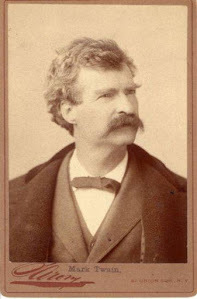
Mark Twain in New York City in 1883, the year he wrote "The Thumb Print." "Courtesy of the Center for Mark Twain Studies, Elmira College, Elmira, New York."
The story revolves around two boys: Valet de Chambre (or Chambers) who was born into slavery (with 1/32 black ancestry) and Tom Driscoll who was born white. The boys look similar and are switched in their cribs by a young slave girl who fears for the safety of her light-skinned child. She switches her son with that of her master's. Each grows into the other’s social role.
David Wilson, an unsuccessful lawyer, moves to town and makes a clever remark which is misunderstood. That causes locals to brand him a “pudd’nhead” or nitwit. When a murder occurs, Wilson solves the mystery in a courtroom scene where he uses fingerprints left on a knife to announce the real murderer.
Writing in Courthouse News Service, (Oct. 28, 2009), Adam Klasfeld said, "Twain turned out to be as prophetic a forensic analyst as he was a social critic. Fingerprinting was a fringe idea at the time this novel was published, vaguely known about but rarely practiced in criminal justice until the turn of the century."
In 1892, British scientist Sir Francis Galton (1822-1911) published Finger Prints, his treatise on classifying a person's digital marks. The treatise was published nine years after Twain's short story, A Thumb Print.That same year, in Buenos Aires, Argentina, detective Juan Vucetich solved a murder using thumbprints found at the crime scene. This is considered to be the first homicide solved by fingerprint evidence.

Sir Francis Galton displayed his own fingerprints on his title page, Finger Prints(London: Macmillan and Co., 1892).
In June 1902, Scotland Yard, a metonym for London's Metropolitan Police headquarters, solved its first burglary case based on fingerprints when the accused left an impression of his left thumb on a newly painted windowsill.
Later in October of 1902, France's landmark Scheffer case was the first to identify, arrest, and convict a murderer based upon fingerprint evidence. Alphonse Bertillon identified the thief and murderer, Henri Leon Scheffer, when his prints were found on a fractured glass showcase after a theft in a dentist's apartment where the dentist's employee was found dead. Scheffer had previously been arrested and his fingerprints were already on file.
Bertillon (1853-1914) was Paris' chief of criminal identification and subsequently developed anthropometry, or the Bertillon system, which measured twelve characteristics of the body. It helped to determine if arrested suspects had been involved in previous crimes.
In 1903, the state of New York developed the American Classification System of fingerprinting all criminals and the science of fingerprinting spread nationwide. The following year, the U.S. Government recorded fingerprints of inmates at Leavenworth, KS federal prison which marked the beginning of the government's fingerprint collection.
Sir Arthur Conan Doyle's (1859-1930) short story, The Norwood Builder (The Strand Magazine, 1903), features his celebrated sleuth Sherlock Holmes in which the discovery of a bloody fingerprint helps him expose the real criminal and free his client.

The British writer R. Austin Freeman (1862-1943) wrote a series of medical-legal detective novels featuring Dr. John Thorndyke, which set the stage for the forensic science detective novel. His first Thorndyke novel, The Red Thumb Mark (Collingwood, 1907), involves a forged bloody fingerprint left on a piece of paper together with a parcel of diamonds inside a safe box. Dr. Thorndyke investigates and defends the accused whose fingerprint matches that on the paper, but after the diamonds had been stolen.
In his investigation, Dr. Thorndyke compares his client's thumb print with his aunt's Thumbograph, which was a popular form of autograph book sold in England in the early 1900s. People often captured fingerprints of relatives, friends, and others they admired, and used the exercise as an after-dinner amusement. A person would ink a finger and print it on the right side of the Thumbograph and autograph the left with a date. The Thumbograph also appears and disappears from a locked library in the 1938 mystery novel, The Crooked Hinge by John Dickson Carr (1906-1977) published by Hamish Hamilton, UK and Harper, US.
Freeman shaped other stories around forged fingerprints in "The Old Lag" (1912), "The Cat's Eye (1923), Mr. Pottermack's Oversight (1930), and When Rogues Fall Out (1932)—an appropriate title for this edition, I might add.
British science journalist Laura Spinney writing in Nature (March 17, 2010) says, "Even fingerprinting's harshest critics concede that the technique is probably more accurate than identification methods based on hair, blood type, ear prints or anything else except DNA. Granted, no one has ever tested its underlying premise, which is that every print on every finger is unique. But no one seriously doubts it, either. The ridges and furrows on any given fingertip develop in the womb, shaped by such a complex combination of genetic and environmental factors that not even identical twins share prints. Barring damage, moreover, the pattern is fixed for life. And thanks to the skin's natural oiliness, it will leave an impression on almost any surface the fingertip touches."
Editor Louise Harnby writes an excellent blog, “Fingerprint forensics for beginner crime-fiction writers,” in which she offers tips to help writers get the science right in fiction, as well as a list of valuable resources. Another excellent resource is The Fingerprint Sourcebook, published by the U.S. Department of Justice which can be read free online, and Fingerprints: The Origin of Crime Detection and the Murder Case that Launched Forensic Science, by Colin Bevan (Hyperion, 2001).
AUTHOR'S NOTES:
• Long before Twain was born, a treatise was written in China (about 200 B.C.) on the potential for using fingerprints as a means of identification and used as evidence in a burglary investigation during the Qin Dynasty (221-206 B.C.). In the age of Babylon (about 4,000 years ago) fingerprints were used to sign written contracts and records have shown that officials took fingerprints of people who had been arrested. Unfortunately, this knowledge was lost to folklore and during Twain's lifetime, no system existed for the forensic use of fingerprints.
• Since 1924, the Federal Bureau of Investigation has managed a database which today contains an estimated 70 million fingerprints and more than 1.5 million non-criminal fingerprint records. Its Integrated Automatic Fingerprint Identification System examines more than 85,000 inquiries per year and can respond in about 27 minutes.
• The scientific study of fingerprinting is called dermatoglyphics, a term invented in the 1920s and founded by Harold Cummins, M.D. (1894-1976).
March 5, 2021
HOORAY, IT’S THE PANDEMIC! (Just kidding.)
by Gayle Lynds
Well, not entirely kidding. There were (surprisingly) some really good things. This month marks a full year of quarantining for many of us who didn’t have to leave home to work. We are grateful, John and I, to have been able to stay here.
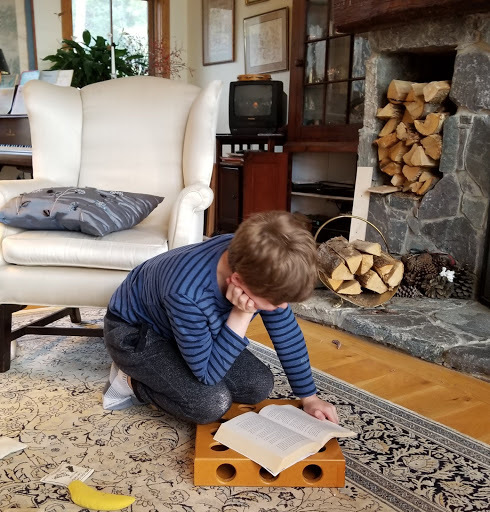 Remember last March as the pandemic was just starting to hit? How does one deal with such a dangerous and unpredictable time? Sometimes it felt as if the ground under our feet was quicksand. Under stress, most of us fall back on habits of a lifetime while integrating what one must from the present. So we coped, and we hoped.
Remember last March as the pandemic was just starting to hit? How does one deal with such a dangerous and unpredictable time? Sometimes it felt as if the ground under our feet was quicksand. Under stress, most of us fall back on habits of a lifetime while integrating what one must from the present. So we coped, and we hoped.Here’s the story of my side of our little family, and a pandemic gift we stumbled on that has brought all of us closer, even though some of us live thousands of miles apart....
My daughter figured out public schools in Brooklyn were going to close, so she, her husband, and my grandson escaped with a packed car and two frisky kitties and moved in with us near the beginning of March. We’re fortunate to live in a forest with lots of outdoor options, and our house has two floors, one of which easily absorbed a second family. Thankfully, the kitchen is large, too.
 There were downsides of course. While everyone else in the place continued to work their jobs virtually, I became my 9-year-old grandson’s #1 helper with school and homework. I’d been using computers for three decades, which gave me some confidence I’d be able to figure out how to do remote learning. Right.
There were downsides of course. While everyone else in the place continued to work their jobs virtually, I became my 9-year-old grandson’s #1 helper with school and homework. I’d been using computers for three decades, which gave me some confidence I’d be able to figure out how to do remote learning. Right.We bought a Chromebook and dove in. He’d never had his own computer, is highly active, and smarter than me. As for myself, I couldn’t remember fractions or algebra (yes, he was doing rudimentary algebra!), and I found I wasn’t as patient as I wanted to be. The “classroom” system of learning baffled both of us, then made us crazy, which means it probably made the teachers even crazier.
But there were moments of fun when we discovered we had simultaneous reactions — throwing up our hands together in despair, walking away when it just got too hard, but then shouting hooray every time we figured something out. We’d look at each other and find ourselves smiling. He became adept using the Chromebook in ways I still don’t understand, but then kids are that way. And we grew wonderfully close.
 Meanwhile, my son had been isolating with his family in suburban Maryland from the first of the month, because the day he returned to his office from a vacation, someone down the hall hadn’t come in because she’d been diagnosed with the coronavirus, the first victim in a very large office building. It was an ominous event not only for the patient and her family, but for everyone else who worked in the close-knit group.
Meanwhile, my son had been isolating with his family in suburban Maryland from the first of the month, because the day he returned to his office from a vacation, someone down the hall hadn’t come in because she’d been diagnosed with the coronavirus, the first victim in a very large office building. It was an ominous event not only for the patient and her family, but for everyone else who worked in the close-knit group.Because there are serious health issues in his family, my son takes no chances. He packed up his stuff, went home, and set up an office in his basement. From that point on, he, his wife, and their daughter stayed in their house and backyard, working and going to virtual school. And they got lonely.
The last of my side of the family — my stepdaughter and her husband — live in a rural valley in Southern California and were also isolating. Over the last year, they’ve endured wildfires, floods, and a mudslide that took out their road. (It could’ve been much worse!) They’re two musicians who have each other, their bicycles, their instruments, and three bossy cats for company. Still, they got lonely, too.
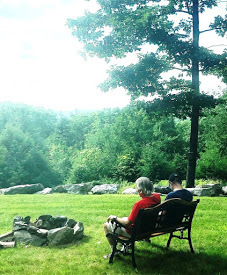 Back here in Maine, no matter how busy the five of us were, and how much time we spent together, we sensed we were missing something as well. Our pre-pandemic lives likely had been very much like yours, with trips to grocery stores, dinners with friends, movies, simple things like that, but as March passed into April, we began to understand all of that was over not just for now, but for no-one-knew how long.
Back here in Maine, no matter how busy the five of us were, and how much time we spent together, we sensed we were missing something as well. Our pre-pandemic lives likely had been very much like yours, with trips to grocery stores, dinners with friends, movies, simple things like that, but as March passed into April, we began to understand all of that was over not just for now, but for no-one-knew how long. Becoming lonely for our “before” life morphed into something difficult to describe, a feeling perhaps, an emotion. It was like an open door that just wouldn’t fit into its historic frame.
This is when a mini-miracle occurred. My son, who is notorious for not answering phone calls or emails or text messages, announced all of us needed to meet weekly for a family Zoom. As far-flung as we are in normal times, and as infrequently as we’re in touch even then, this was a revolutionary concept.
What? ‘See’ each other every week even though we don’t live nearby? It’d been years since all of them had been in school and living at home with us in Santa Barbara....
There’s something unsettling about making a commitment to reverse a longstanding (a couple of decades’ worth of) habit. What if we found we bored each other? Or argued? Worse ... what if we discovered we didn’t really like each other all that much anymore?
I was put in charge. I learned how to create a free Zoom. I sent out invitations. And here we are, all of us nearly a year later, with my daughter and her family back home in Brooklyn, still meeting weekly.
 We celebrate birthdays and anniversaries together. We discuss baseball and football, which is reliably lively since we don’t all cheer for the same teams. The grandkids drop by to wave and relate news. Last weekend, my granddaughter was riding the family’s stationery bike to earn screen time. Some of us hold up our cats in greeting. Others of us cook and Zoom at the same time. Or eat and Zoom. No one is bored. Everyone shows up most of the time.
We celebrate birthdays and anniversaries together. We discuss baseball and football, which is reliably lively since we don’t all cheer for the same teams. The grandkids drop by to wave and relate news. Last weekend, my granddaughter was riding the family’s stationery bike to earn screen time. Some of us hold up our cats in greeting. Others of us cook and Zoom at the same time. Or eat and Zoom. No one is bored. Everyone shows up most of the time. We’ve grown a connection among us that feels alive and nurturing. We are alone physically, but not emotionally. The door to life fits into its frame again, and we have a family closeness we’d forgotten.
Dear Rogue Reader ... What have you found to make the pandemic better for you?
March 3, 2021
SHERRY KNOWLTON GOES ROGUE ... JOIN HER IN BOTSWANA!
Gayle Lynds: Sherry Knowlton has an adventure with each of her award-winning books, and the location of her new one, Dead on the Delta is a real humdinger – Botswana, Africa. Why there? Because her heroine, lawyer Alexa Williams, decides to hie herself off to spend four months researching lions, looking forward to “witnessing the elemental life-and-death struggle of the African wild.” Instead Alexa ends up being hunted on the vast Okavango Delta.
So what’s a writer to do about a location so far away and, well, exotic? She must visit first. Here’s Sherry’s tale before the tale...

I research all my books, some on site in places like the fracking fields of Northeastern Pennsylvania or Virginia’s Shenandoah Valley. So, when I decided to set my next Alexa Williams book in Botswana, what a wonderful excuse for a safari.
My husband and I have been on safari multiple times, and I especially love Botswana’s Okavango Delta. But experiencing Africa for the sheer joy of the adventure is different from absorbing enough information to credibly weave together the elements of the suspense thriller that I wanted to write.
There were things I needed to know. About animal patterns, poaching, Botswana’s famed anti-poaching force, government and politics in the country, lion research and more. Plus, I’d never been to the capital city of Gaborone or spent more than a few hours passing through the small town of Maun, the gateway to the Okavango.

So, my husband, Mike, and I flew off to Botswana and Southern Africa for four glorious weeks. The core of that time we spent on safari in Botswana, Zambia, and Zimbabwe with some friends. That immersion in the wild was amazing. We observed the Big Five and countless more species from small planes, safari vehicles, boats, and on foot. Our great guide was Dave Luck, who our host company, Wilderness Safaris, calls one of their most experienced and knowledgeable. Most important, Dave set aside plenty of time for me to pepper him with my constantly evolving list of research questions.
Before and after our safari, Mike and I spent time on our own, carrying out my research mission. Upon arrival in Johannesburg, we took a day to adjust to the time zone, and then hopped a plane to Gaborone. While there, I met with a contact from the US Embassy who had agreed to give me off-the-record background for the book.
 Our other days in Gaborone were devoted to touring; learning the neighborhoods, observing life in the streets and halls of government, and learning about the HIV/AIDS infrastructure that supports the medical needs of a country where 25% of the adult population is infected with the disease.
Our other days in Gaborone were devoted to touring; learning the neighborhoods, observing life in the streets and halls of government, and learning about the HIV/AIDS infrastructure that supports the medical needs of a country where 25% of the adult population is infected with the disease.In a great compliment to the mystery genre, our city guide made sure that we stopped at several sites that figure prominently in The #1 Ladies Detective Agency series and television adaptation of the books. Early on, it took me a few minutes to realize that when he spoke familiarly of Precious and Grace, our guide meant the fictional Precious Ramotswe and Grace Makutsi from the books. Alexander McCall Smith is a legend in Gaborone.
[image error] The highlight of my research came when Mike and I headed back to the Okavango to spend a few days with lion researcher Robynne Kotze. In my planning for the trip, Wilderness Safaris helped arrange time with Robynne.I’m so grateful to her employer, the University of Oxford’s WildCRU unit, for allowing her to engage with me in the field. Generous and enthusiastic, Robynne educated me about the life of a lion researcher, study methodologies, conservation issues, politics in Southern Africa and more.
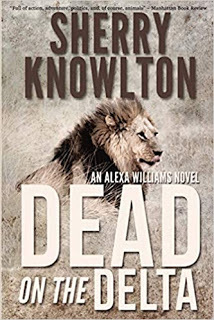
Robynne and her group work on a research project called the Trans-Kalahari Predator Programme which studies lion populations in both Botswana and Zimbabwe. The Director of the project, Dr. Andrew Loveridge, has written a book about his experience as the researcher who had long studied Cecil the Lion until the famous cat was killed by an American big game hunter.
Most fun were the hours we spent driving through the bush, looking for lions with Robynne. One of the handsomest fellows we encountered even made it to the cover of Dead on the Delta. The cover artist was able to use my husband’s photo of this striking lion as the basis for his design.
For the next Alexa Williams novel, I’ll probably return the action to Southcentral PA, the primary setting for the earlier books. But, what’s the lesson I’ve learned from my African research experience? Make sure I send Alexa to many more exotic settings around the world.
Fiji? Bali? Nepal? The opportunities for hands-on research are endless.
What about you, Rogue Readers ... where would you love to visit someday?
March 1, 2021
ROGUE WOMEN FEBRUARY ROUNDUP!
 Here's what we Rogues talked about, researched, and revealed in February...
Here's what we Rogues talked about, researched, and revealed in February...
As we geared up to celebrate Valentine's day, Karna Small Bodman gave us a little rundown of the history of the day and some great reading recommendations.
ZJ Czupor took us on a deep dive through the phenomenon of doppelgängers in science and literature.Author of The Mercenary, Paul Vidich, shared his expertise and top tips for researching a historical novel.
Book rejection can be really difficult to navigate, and Lisa Black opened up with us about how she's persevering through her "book-less 2021."
Valentine's Day isn't just about romantic love. And for all who might rather read less conventional tales this month, Jenny Milchman shared her favorite "not romantic love" book list!
As a sneak preview to an X-Treme CrafFest session airing in July, Chris Goff shared some of her musings about how to craft compelling character relationships based on real life relationships.
J.T. Ellison, the "Thriller Chick" herself, was a guest on our blog. She gave us some special insight into the context of her upcoming March release, "HER DARK LIES."
February 26, 2021
J.T. ELLISON GOES ROGUE
Karna Small Bodman: We are delighted to welcome New York Times and USA Today bestselling author of more than 25 novels and the EMMY award winning co-host of the literary TV show, A Word on Words, J.T. Ellison. With millions of books in print, her novels have been published in 25 countries. Here J.T. tells us where she got the inspiration to write her new thriller, HER DARK LIES, described as one featuring a mystery, a ruined wedding dress and troubling shadows hovering over what should be a lovely wedding in an idyllic setting.
by J.T. Ellison
For those who know me, it’s not a surprise that my latest novel is set off the coast of Italy. My family is Italian and live in the Piedmont region, so any excuse to visit, I find.
Our last trip to visit family was a bit of a disaster. We went to Italy to celebrate my major milestone birthday. It was my parents, my husband and myself, my brother, and one of my nephews.
It rained, almost every day. We all caught terrible colds. We tend to migrate around when we travel, in order to see and experience as much as possible, and there were six of us (sometimes eight) in a rented van (nicknamed, appropriately, Van Go) barreling around the Italian Alps, sneezing and coughing, and, well, arguing. If you’ve ever been sick on vacation, you understand. It’s ten thousand times worse when you’re not at home. Being overseas, it is one heck of a challenge.
Como was our last stop, and we planned to be there three days before flying home. Traffic was awful, the roads so narrow we nearly scraped off the mirror a few times. Add in the sneezing, coughing, shouting — in Italian and English — by the time we alighted on the shores of Lake Como, everyone was primed for murder.
Thankfully, we found some excellent codeine-laced cough drops and soldiered through. There was good wine, of course. Our room had a beautiful terrace that overlooked the lake, and miracle of all miracles, when we woke, the sun was shining. My birthday had arrived, and finally, things were looking up.
I’d lost my voice at that point (a decennial tradition) but this was my first time on Lake Como, so I packed up a box of tissues and we caught the ferry. We toured around on the lake all day, disembarking at the various towns, gobbling down risottos and Prosecco. Eventually, we simply sat in our seats on the ferry’s top deck and motored around the lake. It was a wonderful day.
Spirits restored, we settled in for a special birthday dinner. As the wine arrived, a yacht pulled up to the dock on Comacina, Como’s sole island.
A wedding party emerged, disappearing into the island’s heart. It’s become something of a family joke — it never fails, no matter where we are, we run into a wedding. We could hear the makings of a grand party going on. As we were served dessert, fireworks began. I was wildly impressed that my husband had managed fireworks for my birthday, but quickly found out it was a Comacina wedding tradition.
We all had a good laugh, and I knew immediately I had to find a way to write this into a book. The setting, the yacht, the wedding, the fireworks. Murderous intentions. A novel was born.Comacina has a number of legends surrounding it, which piqued my interest to do more research in the area. But to achieve my vision for the novel, I also needed crashing waves, extreme isolation, and a sheer cliff face, so I married Comacina with Capri for the cliffs and grottos, set it off even farther west where no one can reach it easily, and put a grand fortress on the cliff. Only later did I realize I’d put my fictional Isle Isola smack dab in the Tyrrhenian Sea between the Scylla and Charybdis. So fitting.
Being on an island in the middle of the sea, only accessibly by yacht, hydrofoil, or helicopter, during the stormy season, amped up the isolation needed to make HER DARK LIES the ultimate gothic thriller. Its roots are as Italian as I am. I can’t wait to go back to Italy and see what sparks for me next!
This new thriller will be our March 9. In the meantime, you can visit J.T.'s website here! Thanks, J.T. for being a guest here on Rogue Women Writers.
February 25, 2021
RELATIONSHIPS: FICTION VS. REAL LIFE
The Big Reveal
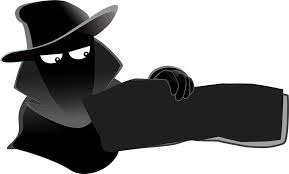 In July, I will have the distinct pleasure of discussing this topic with fellow Rogue Carla Neggers in our X-Treme CrafFest session entitled “Character Relationships,” airing during Virtual ThrillerFest XVI, June 28-July 10, 2021. Attendees can tune into over 100 conversations featuring over 200 industry professionals, all discussing specific aspects of the writing craft: setting, dialogue, conflict, opening sentences, etc.
In July, I will have the distinct pleasure of discussing this topic with fellow Rogue Carla Neggers in our X-Treme CrafFest session entitled “Character Relationships,” airing during Virtual ThrillerFest XVI, June 28-July 10, 2021. Attendees can tune into over 100 conversations featuring over 200 industry professionals, all discussing specific aspects of the writing craft: setting, dialogue, conflict, opening sentences, etc. So what do Carla and I know about Character Relationships?
A lot! I am the author of eight books—six in a Birdwatcher’s Mystery series and two international thrillers. I’ve been nominated for a lot of awards, won a few and honed my craft for nearly 30 years.

Okay, I admit, I have ten years’ worth of learning curve sitting in boxes in my basement. At least four novel attempts and a slew of short story attempts. But who doesn’t?
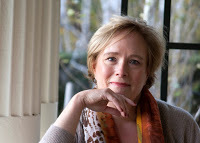
Carla, maybe!
She is the New York Times bestselling author of more than 75 novels, including her acclaimed Sharpe & Donovan suspense series. Her books have been translated into two dozen languages and sold in over 35 countries.
I’m in awe.
But I digress.
In the world of crime fiction, there is an ongoing debate about what’s most important– character or plot. As a beginning writer, I would have said plot. After all, it’s the pulse-pounding ride that makes a thriller so exciting, right? It’s all about the chase to the end to see justice triumph. But, as a seasoned writer, I’ve changed my mind. After eight books, I’ve come to the realization…
It’s character that drives the story.
After all, justice looks differently to different people. How justice looks depends on whether you’re the protagonist or the antagonist, the wife or the other woman, the boss or the employee.
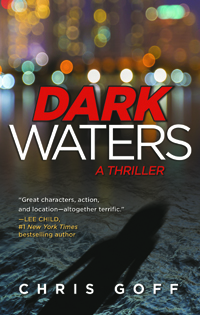 It took me years to complete my debut thriller, DARK WATERS. The idea came to me in 1999. I was in Israel for eight weeks with my daughter. She was eleven and there receiving medical treatment. I was the parent on the ground. I had just turned in my first book in the Birdwatcher’s Mystery series, and was under contract for four more in the series. I knew I should be working on Book #2. Instead, I spent the eight weeks focusing on my daughter and taking notes. Lots of notes. The more I watched, the more I was struck by the by the complexity of Israeli society. There were lots of Jews, who believed different things. Some weren’t religious, some were. Some were orthodox, some were ultra-orthodox. There were Israeli Arabs, separated by a border wall from their Palestinian relatives. I was enthralled with how many similarities there were to things happening at the borders in the US.
It took me years to complete my debut thriller, DARK WATERS. The idea came to me in 1999. I was in Israel for eight weeks with my daughter. She was eleven and there receiving medical treatment. I was the parent on the ground. I had just turned in my first book in the Birdwatcher’s Mystery series, and was under contract for four more in the series. I knew I should be working on Book #2. Instead, I spent the eight weeks focusing on my daughter and taking notes. Lots of notes. The more I watched, the more I was struck by the by the complexity of Israeli society. There were lots of Jews, who believed different things. Some weren’t religious, some were. Some were orthodox, some were ultra-orthodox. There were Israeli Arabs, separated by a border wall from their Palestinian relatives. I was enthralled with how many similarities there were to things happening at the borders in the US. It was right at the time when suicide bombings were gearing up, and the fear and anger was palpable.
Later, when I worked on the book, it was the characters in my book that made the story work. It was their differences, offset by their similarities and their common goals, which drove the plot and made the story come alive.
The good the bad and the ugly.
It is incredible how nuanced relationships are. You can love someone and still not like them. You can be in awe of someone’s accomplishments, but despise them as a human being. You can try with every fiber of your being to make someone understand, and still not be able to make them comprehend.
And that’s what makes it interesting!
Like in real life, it’s the push and pull between characters that captivates the readers. Who is smarter, the villain or the protagonist? Does the person your character loves unconditionally, place conditions on their relationship? Do the characters have different belief systems and yet want the same outcome? For the same or for different reasons?
I’ve spent the past few days thinking about what I want to say in our session, and what I want to ask Carla. I know there’s a lot I can learn from her. And for the past week, I’ve been taking notes again, and begun tweaking Operation Gentoo. One thing I know for certain, the stronger my characters, the better the book.
If you could share one truth about relationships or character, one thing you’ve learned over the years, what would it be?
February 19, 2021
NOT ROMANTIC LOVE: 8 THRILLING READS FOR FEBRUARY
Did anybody else have those carnation campaigns around Valentine’s Day in high school? I think they were a student council fundraiser, maybe to pay for prom. The fact that I don’t really know shows my relationship to the carnation sales (and also to high school). I didn’t even go to prom, and I was never the one getting carnations delivered in every single period, standing up in a for me? dance over and over again. My best friend and I had each other’s carnation backs, saving the other from being flowerless.
Point being, Valentine’s Day can be tough. As a teenager who has yet to experience romance. And as an adult in myriad ways. Plus February is about much more than Hallmark. So I thought I would share some thrilling reads that each embrace a different kind of love.
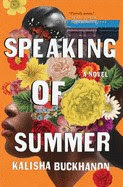 Love for a Twin Sister
Love for a Twin Sister
Speaking of Summer by Kalisha Buckhanon
Anybody who has a sister will relate to the love that infuses this dark literary mystery. Autumn’s twin sister, Summer, disappears one snowy night from a rooftop in Harlem. There is only one set of footprints in the snow, and the door from the building is locked. Intriguing setup—but the strong, beating heart of this story is the lengths to which Autumn will go to find out what happened to her sister, and the tangled, twisted bonds of sisterly love.
 Love for a Cause
Love for a CauseDon’t Turn Around by Jessica Barry
I know, there’re two Jessica Barry novels on this list. She’s, like, [cue tween-y voice] my new #faveauthor This book frightened me to my very toes, as in, I had to stop reading at one point and go stalk around the house to put me back in the Now instead of the terrifying world Barry creates where society is divided, and you can almost (note that I did say almost) see the other’s point of view. In those shades of gray, which Barry delves into furiously well, true terror lies.
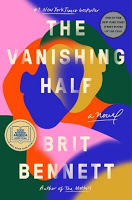 More Twin Love
More Twin Love
The Vanishing Half by Brit Bennett
Another twin sister disappearance novel, dealing with the topics of identity, race, and the dark legacy men leave on women. Is it possible to grab hold of another life, even if it means never seeing your family or going back home again? When Stella Vignes stumbles almost accidentally upon the chance to live as a white woman married to a wealthy businessman, she takes it, although it requires abandoning all that she loves. And then one day, her stack of lies is threatened.
 Mother/Daughter Love
Mother/Daughter Love
Freefall by Jessica Barry
The love a mother has for her daughter propels this wilderness thriller. When a small plane crashes in the Rockies, there are no survivors. Or are there? Because even though Maggie Carpenter hasn’t spoken to her daughter in years, knows nothing about her life, job, or her impending marriage, she can’t believe that Allison perished in that fiery crash. And as Allison makes her way home, her journey places the mother who won’t give up on her in grave danger as well.
 Can’t We Just Be Friends Love
Can’t We Just Be Friends Love
The Lost Night by Andrea Bartz
The love friends have for each other can be as deep as any other. But the flip side is how intense the hatred and rivalries and betrayals can also run. A group of friends has grown up; it’s been ten years since they left their drunken, partying days behind, with one key member dead. But when one of the living starts to wonder why her memory of the last night they spent together is so cloudy, everything else has to be questioned too. Hipster Brooklyn and millennial life are put vividly on the page, as well as the reality of what happens when we leave our youth behind with secrets still buried.
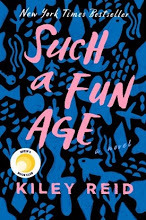 Love for a Child Who Isn’t Your Own
Love for a Child Who Isn’t Your OwnSuch a Fun Ageby Kiley Reid
How much must you love kids to be a professional nanny? Arguably, Emira Tucker behaves more lovingly to her three year old charge, Briar, than does Briar’s snooty, entitled mom. But when Emira is accused of kidnapping little Briar in an upscale grocery late one night after her employers have leaned on her to work extra hours, all you-know-what breaks loose in the upper crust neighborhood where the Chamberlains live, on the media, and in mom Alix and nanny Emira’s lives. Especially because Emira is in no way a kidnapper, and Alix doesn’t know her three year old at all.
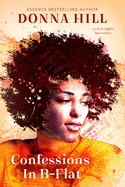 Love for an Era
Love for an EraConfessions in B-Flatby Donna Hill
This is the most traditional love story of my selections. Will Jason Tanner, a new arrival to New York City at the height of the civil rights movement, who comes bearing the anti-war message of Dr. Martin Luther King, woo beat poet, Anita Hopkins, a devotee of Malcom X? But this novel is also a love letter to an era, one we in many ways need to revisit, rediscover, and reboot now, as we seek to build new and loving binds with each other.
 Love for a Stranger
Love for a Stranger Before She Disappeared by Lisa Gardner
Frankie Elkin is Lisa Gardner’s new heroine, a woman who seeks and finds people who’ve been forgotten to the world, their lives, even their own families. There are so many people truly alone in the world, or who feel alone in it, and that’s why everybody needs a Frankie: fierce, dogged, and brave. Because this is a Lisa Gardner novel, we know the character will come riddled with flaws that make her relatable and real. But you also know you’ll find in Frankie a heroine for the times, along with the truest message of love, which is: Never, ever give up.
What's on your Valentine's month reading list? Let us know!
February 12, 2021
MY BOOK-LESS 2021
By Lisa Black

I will not have a new book coming out in 2021.
Last summer I finished what I thought would be the first book in a new series. My protagonist could be described as ‘like Jack Reacher, if Jack Reacher were a fortyish ex-housewife with no martial arts training.’ I loved it. My agent was enthusiastic about it. We sent it to the publisher.
The publisher said: No.
Not ‘this needs some work.’ Not ‘the villain isn’t convincing.’ Not ‘here is ten pages of suggested changes.’
Just ‘no.’
They did add: ‘But you know what we’d really like…’
In the writing world, having a book rejected is not only a shock, an interruption to the publishing schedule, a pain in the #*&^$ neck and possibly a financial hardship, but it really hurts your feelings. It’s a punch to the gut like your mother throwing your drawing away instead of hanging it on the fridge. It’s like spending your senior year working up the courage to ask a particular person to the prom and when you do, they give a snorting laugh and walk away. It’s like overhearing your spouse confiding to their best friend that they should have married the person they dated before you.
It is, in a word, the worst.
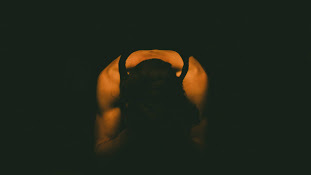
In case I haven’t made it completely clear, it’s not only that a year of your life has been utterly wasted. (Sure, you can tell me it was a learning experience and all for the best and it will make me a better writer, but I won’t believe you. On principle, I won’t believe you.) It’s not a matter of second guessing, such as: Did I choose the wrong setting? A boring title? Maybe I should have given my character red hair.
No, a rejection this flat makes you doubt your very sanity. Am I so out of touch with reality that I thought this was a good book? Am I crazy, or just stupid?
Of course I handled the whole thing with maturity and professionalism. For example, I moved through the seven stages of editorial rejection in record time:
Disbelief: What, no? You’re just going to say no? As in, like, no?
 Denial: This can’t be right. Is my editor on vacation? Did the snarky temp at the front desk write this email?
Denial: This can’t be right. Is my editor on vacation? Did the snarky temp at the front desk write this email?Bargaining: What if I throw in a sex scene? What if I make the character twenty years younger and a one-armed trapeze artist who escaped from a circus in Uzbekistan?
Guilt: This is karma for not completing the three-page character profile of the protagonist’s second cousin.
Anger: The publishing world has been taken over by uncouth mercenaries who wouldn’t know a good book if they were stuck overnight on the Flushing line with nothing but a copy!
Depression: I suck. This book failed because I suck, have always sucked, and they probably only published all those other books because my mom made them.
Acceptance: All right—what would you, publisher, really like? [Maybe I can repurpose this manuscript down the road….]
But of course, it was 2020. The country, the entire planet, was having the worst year ever and I’m going to publicly weep and moan because I typed ninety thousand words that no one wants to read? Complain to my husband, who was out of work for 8 months? To my niece who’s trying to teach middle-schoolers via Zoom? To friends and family who have loved ones in the hospital with Covid-19? Nope, not an option. Besides, who wants to advertise the fact that they crashed and burned into a still-smoking heap of failure?
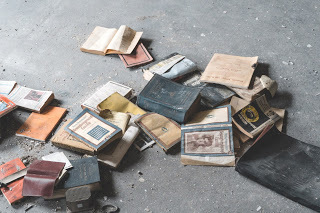 So there I was, wallowing in a writer’s peculiar and lonely kind of misery—but here’s the kicker: I actually mean this to be an inspiring blog. Because I’d been there before, and survived.
So there I was, wallowing in a writer’s peculiar and lonely kind of misery—but here’s the kicker: I actually mean this to be an inspiring blog. Because I’d been there before, and survived. I’ve had a book rejected before, a previous year of my life tossed in the can. I’ve had chapters axed, a character completely remade, book ideas vetoed without even an outline read. Once before an editorial meeting I spent ten minutes explaining my next plot to my agent only to be warned: “Yes, well, don’t say that. Say pretty much anything but that.”
There is a lot of rejection in the writing life, and yes, you have to get used to it. But you also have to believe that it’s only a rejection of this particular piece of writing. It’s not a rejection of you. Writers write a lot of stuff--some of it works out, and some of it doesn’t.
You only fail when you let it stop you.
So tell me, dear readers: when did you refuse to let a setback stop you?
February 11, 2021
FIVE KEYS TO SUCCESSFULLY RESEARCHING AN HISTORICAL NOVEL

The Memorial Wall in the lobby of CIA Headquarters in Langley Virginia has 133 black stars carved into Vermont marble. Each star represents a fallen agency officer. Many are named, but a few are identified only by the date and place they died. My new novel, The Mercenary, is inspired by one anonymous man represented by a star. Initially, I was intimidated by the challenge of telling the story of a high-ranking KGB officer exfiltrated by the CIA, not because it was about Cold War spies, (I had addressed this world in my previous novels), but because my novel was to be set in Moscow, a city I had never visited – and couldn’t in the pandemic.
I wanted to make sure The Mercenary evoked a vivid sense of Moscow in the last years of the Soviet Union. To create an authentic sense of that place and time, I knew I would have to do a great deal of research. Before sitting down to write the novel, I did six months of extensive research to get five things right: setting, characters, dialogue, location, and the historical context. This breakdown was helpful for my spy novel, but it can offer readers and writers useful tips for any type of novel research.
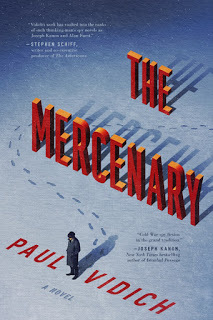
SETTING: Setting may be the novelist’s first critical choice. Setting means a certain place at a certain time where the story unfolds. Setting is not just scenery, or nice descriptive passages, although an illustrator’s eye for a place is part of it. It’s about mood, it’s about the things that draw a character to a place, establishes the novel’s atmosphere, and evoke the story’s imaginary world. Setting provides the yearnings, fears, attractions, and possibilities that are available to characters who find themselves at a unique moment in a particular place. It is the stage for the characters whose stories will be told.
BELIEVABLE CHARACTERS: In The Mercenary, I needed to imagine men and woman whose choices, values, and actions were convincing and of the era. I read several autobiographies of high-ranking KGB officers who successfully defected to the West. Their stories are gripping real-life accounts of spies and they paint a graphic picture of the paranoia, incompetence, intrigues and sheer nastiness of the KGB. I was able to understand the hopes and fears of men who were caught in the Soviet system, and once I inhabited their world, I created Viktor Petrov, a KGB Lieutenant Colonel who wanted out. He became a whole person who lived in a specific apartment block, drank too much, spoke with a provincial accent, and cared deeply for his son. I created him, as all writers create characters, by accessing my own emotions and psyche, combining them with the real-life accounts of the KGB officers, and then I scraped all this material into a mental space, breathed on the ember, and gave life to Petrov.
DIALOGUE: It is critical. It reveals character and it drives plot. But to make dialogue authentic, you need to know your character well. I listened to the voices of the Russians who I researched and developed an ear for imitation. Often writers make the mistake of describing a character to help the reader imagine, but writers sometimes wrongly use Somerset Maugham’s technique of sumptuously describing a person’s aquiline nose, grey eyes, knitted brow, and so on, and by the time the reader has finished the paragraph the reader still doesn’t have the faintest idea what the person is like. But if the character opens their mouth and says something, you reveal them in two or three lines.
LOCATION: In my previous novels, set in Havana and Washington DC., I visited the cities doing something akin to location scouting. I wanted to see where the action happened, the routes my characters took from their hotel, where my characters lived, and what they saw when they walked down the street. I couldn’t visit Moscow in person so I did my location scouting with Google maps. The street view feature allowed me to visit the city virtually. Street names, traffic patterns, pedestrian’s clothing can all be seen. All these little details are important to establish authenticity, but they have to be transparent. If a detail stands out, the writer has failed. There is tendency in historical fiction to show off period details, but a detail that draw attention to itself takes the reader out of the moment.

HISTORICAL CONTEXT: I read as much as I could to understand the Soviet Union in 1985. The Afghan War had been raging for several years and the Soviet occupation had become deeply unpopular and depleted the Soviet economy. Details of the historical moment helped shaped the tone of the novel, and became background for several of the characters, allowing me to insert myself into the mind of those characters. Serge Schmemann’s Echoes of a Native Land, a New York Timescorrespondent’s memoir of living in Moscow, provided a stark and moving account of the city in the 1980s that was infinitely suggestive.
Finally, when I had finished a draft of the novel, I looked to see if I could find a sensitive reader whose personal experiences could validate the experience of a foreigner living in the Soviet Union’s pervasive surveillance. I was fortunate to be find John Beryle, American Ambassador to the Russian Federation 2008-2012, who also happened to be a counselor officer in the American embassy in 1985. He provided invaluable insights into specific details, Moscow life, Russian vocabulary, and he corrected mistakes that would only be noted by someone who lived and breathed Moscow in the ‘80s.
The writer’s sleight of hand is to create a world that is authentic to the reader. It is not easy to do, but it’s what makes the books we admire succeed.
What are some of your favorite tips, tricks, and strategies for writing an historical novel?
February 9, 2021
MYSTERY MINUTE GOES ROGUE
By Z. J. Czupor
 Doppelgänger: Myth, Literary Device, or the Real Deal?
Doppelgänger: Myth, Literary Device, or the Real Deal?Unless you are an identical twin, would it unnerve you to bump into your dead ringer … your doppelgänger?
Would your lookalike be your exact double, your evil twin, or just a mischievous spirit?
When a carbon copy character emerges in literature, the author is playing with our sense of reality. In a novel, when another duplicate self appears, doubts automatically surface. The main character questions the double's identity (who are you?) and the main character questions him or herself, (who am I?). In other words, the use of a doppelgänger as a literary device helps writers portray complex characters.
Seeing through the main character's eyes, it sets readers wondering if their protagonist's experience is real, an imagination, or hallucination? That duality inspires terror and dread.
In general, the doppelgänger creates a creepy or eerie tone within a story, possibly because we see ourselves from outside our own bodies. In other literary situations, an incompetent look-alike can be used to humorous effect.
"Doppelgänger" is German meaning "double-goer" or "double walker."

It was introduced by German author Jean Paul, in his 1796 novel Siebenkas. In fact, he invented two words: doppeltgänger, (with a "t") his name for an uncanny lookalike; and doppelgänger, to describe a meal in which two courses were served simultaneously. But it wasn't until 1824 that the latter word stuck to mean "apparition of a living person."
Myths about spirit doubles have been around for thousands of years. In Ancient Egypt, the "ka" was considered one aspect of the soul and depicted as a spirit identical to the body. This myth also lived in Europe, Africa, in Norse mythology, and in English and Irish literature during the 18th and 19th centuries. These oral and written traditions assumed that if you saw your ethereal double, it was a harbinger of bad luck, or … signaled death.
Dueling Natures
Perhaps it was these myths and oral traditions that inspired numerous authors over time to explore our dual natures.
In Fyodor Dostoevsky's (1821-1881) novella, The Double (1846), a mild and antisocial government clerk meets his bold and assertive reflection. The doppelgänger encroaches on the clerk's affairs and drives him mad by the end of the story.
Edgar Allan Poe's (1809-1849) short story "William Wilson" published in Burton's Gentleman's Magazine (1839) is about an English schoolboy who meets another child with the same name and appearance. This spitting image follows William throughout his life and impedes his ambitions.
The doppelgänger, however, is different from the alter ego — the alternate self, which is embodied by a single person, i.e., Superman/Clark Kent or Dr. Jekyll/Mr. Hyde. The device is also different from the imposter who dresses or acts as another character, such as Tom Ripley who pretends to be his Princeton classmate in The Talented Mr. Ripley (1955) by Patricia Highsmith (1921-1995).
Some critics consider the doppelgänger plot ruse to be a cliché, but popular stories still abound in novels, soap operas, TV, film, and video games.
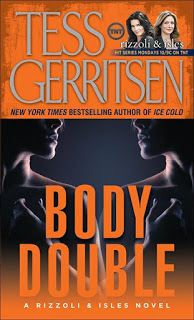
An extensive list of well-known modern mystery and thriller writers has also employed the doppelgänger or evil twin plot tactic, i.e., Stephen King (The Outsider, 2018); Joyce Carol Oates (Jack of Spades, 2015); Tana French (The Likeness, 2008), and Tess Gerritsen (Body Double, 2004) to name a few. The gambit also is popular in romance, science fiction, historical fiction, fantasy, and horror genres.
Are doppelgängers the real deal?
There are several cases in which historical figures have reported seeing their duplicate selves including President Abraham Lincoln (1809-1865) who told his wife, Mary Todd, that he saw his reflection doubled in the mirror with one face beside the other. She said the mirror image looked deathly and foreshadowed bad news. Nevertheless, she thought Lincoln would be re-elected but wouldn't "last through it." Lincoln won re-election but was assassinated forty-two days into his second term.
Neuroscientists claim that intense emotions can cause you to perceive an illusory body which shifts your awareness away from your body to the perception of a separate bodily self. In neuroscience jargon, this is called heautoscopy, where scientists study data from brain scans of patients who experience their "double selves" moving and interacting along with a sharing of emotions and thoughts.
Some physicists have speculated that the "Big Bang" — a theory that our universe was created by a massive explosion—also created a parallel universe. They argue that since space is infinite, matter can arrange itself in a finite number of ways, like cards in a deck. Sooner or later our matter is going to repeat, but not necessarily our mental configuration, which could cause an evil doppelgänger version. For example, in its simplest terms, if you love chocolate, your evil twin from a parallel universe would hate chocolate.
According to folk wisdom, everyone has at least one doppelgänger, or maybe as many as seven other "duplicate selves" walking around the world. Creepy, but not very likely.
There are seven billion people on the planet. There is bound to be someone out there who shares your same features. Right? Scientists, however, claim there's about a one in 135 chance that a pair of complete doppelgängers exist somewhere in the world. But the likelihood of someone walking around looking identical to you, specifically, with your facial features, is only one in 1 trillion.
Psychologist and paranormal investigator Jayne Harris, who authored What Dwells Within: A Study of Spirit Attachment (2015), says, "Whatever the real truth, belief in the spirit double has instilled both fear and wonder in people for thousands of years and will no doubt continue to do so. After all, the wonder of life is surely its mysteries."

How They Met Themselves, watercolor by Dante Gabriel Rossetti (1864).



